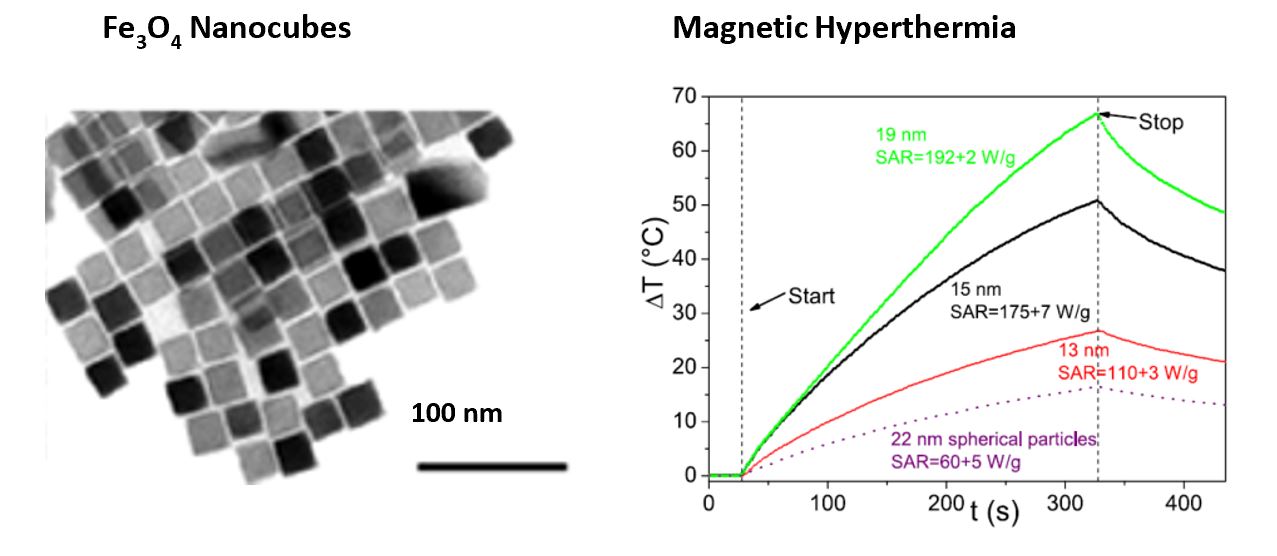Video Article Open Access
Fe3O4 Nanoubes as Versatile Theranostic Agents
J. Nogués 1,3,* , J. Muro-Cruces 1 , A.G. Roca 1 , A. López-Ortega 3 , E. Fantechi 4 , D. del-Pozo-Bueno 5 , S. Estradé 5 , F. Peiró 5 , F. Pineider 4 , C. Sangregorio 6,7 , B. Sepúlveda 1
1Catalan Institute of Nanoscience and Nanotechnology (ICN2), CSIC and BIST, Barcelona, Spain
2ICREA, Barcelona, Spain
3Dept. Ciencias and Institute for Advanced Materials and Mathematics INAMAT2, Universidad Pública de Navarra, Pamplona, Spain
4Dept. Chimica e Chimica Industriale and INSTM, University of Pisa, Pisa, Italy
5LENS-MIND-IN2UB, Dept. Enginyeries Electrònica i Biomèdica, Universitat de Barcelona, Spain
6Dept. Chimica and INSTM, Università degli studi di Firenze, Sesto Fiorentino, Italy
7ICCOM-CNR, Sesto Fiorentino, Italy
Vid. Proc. Adv. Mater., Volume 2, Article ID 2105175 (2021)
DOI: 10.5185/vpoam.2021.05175
Publication Date (Web): 29 Jul 2021
Copyright © IAAM
Graphical Abstract

Abstract
Nanoparticles have attracted an enormous interest during the last decades due to their appealing properties which have led to countless applications in very widespread fields. Interestingly, the physicochemical properties of nanoparticles can be efficiently tuned by designing not only their size but also their shape. For biomedical applications, magnetic iron oxides, either magnetite (Fe3O4) or maghemite (γ-Fe2O3), are becoming the preferred material due to their excellent biocompatibility, biodegradability and relatively high magnetic moment. However, most of the research performed in maghemite/magnetite nanoparticles has been carried out on isotropic spherical particles. Here we present a rationally designed synthesis pathway based on the thermal decomposition of iron(III) acetylacetonate to obtain high quality nanocubes over a wide range of sizes [1]. The nanocubes with an edge length below 17 nm show a great colloidal stability, even after transferring them to water. Moreover, the 17 nm nanocubes exhibit an excellent magnetic hyperthermia and NMR relaxivity performance (better than their spherical counterparts), making them excellent candidates for potential applications in nanotheranostics. In addition, the Fe3O4 nanocubes are outstanding heat mediators for photothermia in the near infrared biological windows (680-1350 nm), with heating efficiencies similar to, or better than, the best photothermal agents. In addition, the magnetic and optic anisotropies of the nanocubes have been exploited for a relatively new approach for in situ local temperature sensing.
Keywords
Iron oxides, nanocubes, anisometric nanoparticles, magnetic hyperthermia, magnetic resonance imaging.
Acknowledgement
We acknowledge the funding of the Spanish Ministry of Science and Innovation (PID2019-106229RB-I00 and RTI2018-095495-J-I00 projects) and the Ramón Areces foundation (MAGPLADRUG project).
References
- J. Muro-Cruces et al. ACS Nano, 2019, 13, 7716.
Biography
Josep Nogués, ICREA Research Professor earned his degree from the Universitat Autònoma de Barcelona (Spain) in 1986. After obtaining his PhD at the Kungliga Tekniska Höskolan in Stockholm (Sweden) in 1993, he moved to the University of California San Diego (USA) to complete his postdoctoral studies. Four years later he returned to the Universitat Autònoma de Barcelona as an associate researcher, becoming an ICREA research professor in 2001. He is since 2006 the group leader of the Magnetic Nanostructures group at the Catalan Institute of Nanoscience and Nanotechnology (ICN2; Barcelona, Spain). Prof. Nogués has published 252 articles (including eight reviews), with over 18,500 citations and an H-index of 59. He is the author of five patents and his work has given rise to over 245 invited talks at international conferences and workshops.
Video Proceedings of Advanced Materials

Upcoming Congress



